I’ve been home for a little over a week from my third trip to the Nancy Crow Barn in Ohio. It’s an intense, exhausting, exciting two weeks immersed in art–not just fiber art, but Art with a capital A, full of exploration of color, line, shape, composition, and design that could apply to any medium at all.
The Barn is not for the faint of heart or the thin of skin.
Every time I go, I feel stripped and renewed all at the same time. And every single time I learn something new that is vital to my growth as an artist. Something that I didn’t know was missing, or couldn’t articulate if I did know.
Nancy Crow is one of the premier artists creating in fabric and thread in the US. She was recently honored in DC by the James Renwick Alliance as a Master of the Medium in Fiber. She teaches her two week retreats as graduate studies in art, and pushes her students to find the edges of their personal envelopes.
This set of classes was called Advanced Compositional Exercises and Creative Stretches. We had been instructed to come with homework that included at least 50 black and white studies and a series of paper collages to use as creative prompts. I had never done so many black and white compositions, and it was a challenge. Most of them were not great, but there were some that had potential, and I definitely understood the reason why we were asked to do them. I was forced to come up with new ideas and new ways of thinking that began to inform my work even before I arrived in Ohio.
I won’t bore you with the details of the exercises, but as usual, the first week was full of ups and downs for me. Some days I felt like I was on the edge of understanding, and some days not so much. My equilibrium was tested right away when the lodging choice I had made for my stay turned out to be not at all what I had expected, and I had to scramble to find an alternative place to stay after the first night!
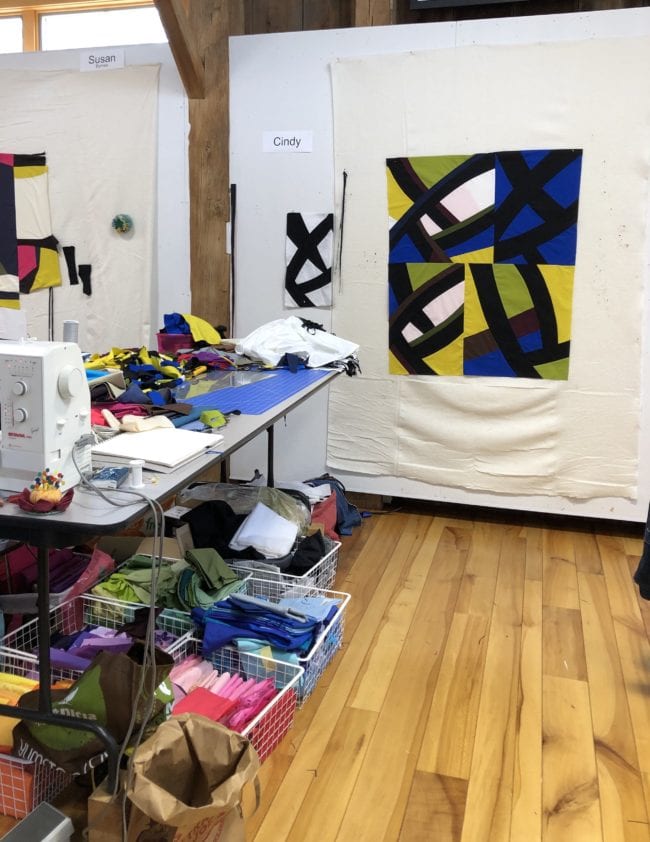
Home Away From Home Spring 2019 Crow Barn – Cindy Grisdela
This was my home for two weeks–from 7:30 AM until about 8:30 or 9 PM five days a week. Meals are provided.
At the end of my first week, I had one medium sized piece (shown above) that probably would need to be tweaked later and one large piece that I disliked intensely until I got started putting the colors in, and then came to like a little better (below). We often rough out a composition in black and white fabric to work out the problems before introducing the complication of color. I chose a difficult motif to start with from one of my black and white studies and it didn’t get easier as I went forward. Not sure it will get quilted because it is enormous–about 70″ w x 80″ high.
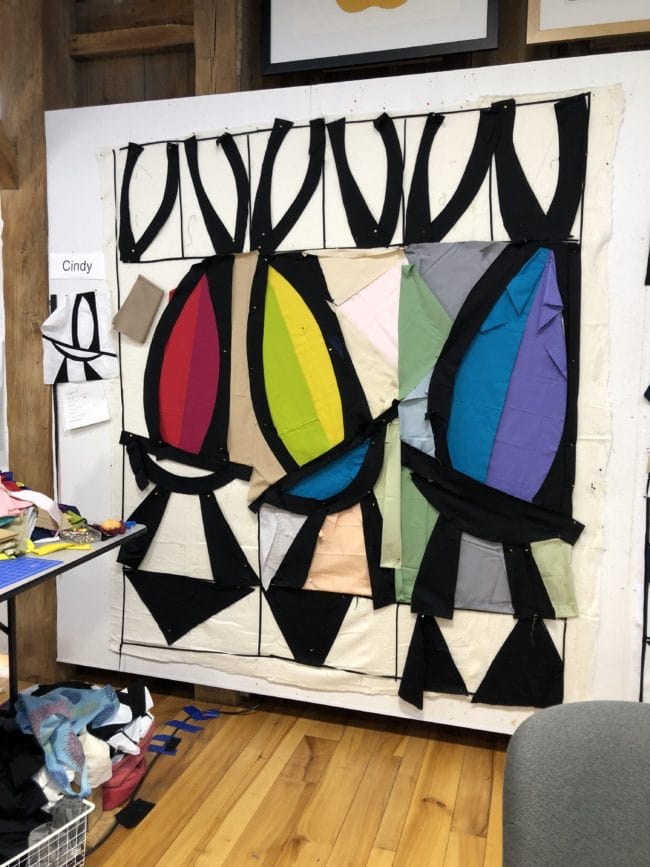
Large Exercise Spring 2019 – Cindy Grisdela
On Sunday of the second week each person gives a presentation of the work they’ve recently. It was fun to see my quilts all hanging together, although I didn’t get much feedback on them. These are the six large scale quilts I’ve finished in the last eighteen months.

Crow Barn Presentation Spring 2019 – Cindy Grisdela

Second Set of Presentation Quilts – Cindy Grisdela
On the second Monday I was determined to stay positive and get as much as I could get out of the second week.
We began by choosing some of our paper collages to interpret in fabric using only black and white. I hadn’t done mine exactly the way she wanted them, but I found some interesting images and set to work. After finishing two studies, I happened to lay a piece of black fabric over the fiddly inserts I’d been working on because I liked the way they opened up space, and realized that the simple composition was much more compelling. Beyond that, I had decided that my focus of the week was going to be on strengthening my eye to recognize strong tension between the figure and the ground in my compositions, and the spare design would force me to be very conscious of that tension.
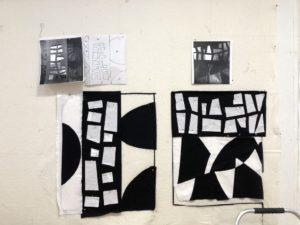
Small Black and White Studies – Cindy Grisdela
As it turns out, that was a fortuitous choice. The second assignment involved making the first design more complicated, and since I had started simple, my composition was ultimately much easier to sew together

Simplified Design – Cindy Grisdela
than it would have been otherwise. Which was a good thing, because the third assignment involved making that design over 10 times using a different color formula each time! Did I mention this is a graduate level course in design and we had about two and half days to complete the assignment?
It helps that I’m a fast sewer, but I wasn’t able to get all 10 done in the time I had. What an amazing, exhilarating exercise! I did the first six, and I am going to finish them at home and then pick another composition and do the exercise again. I’m really looking forward to it because it forces me to really think about my color choices and how they interact–that’s the point of the exercise after all.
So why did I go back and what did I learn?
I go back because I don’t know anywhere else or any other teacher that will push me to the limit this way. I go back because I’ve made friends there, friends who are supportive because we’re all in the same boat, regardless of the fact that we may be at different levels in our artistic development. I go back because I want to grow and evolve as an artist, not just keep doing the same thing over and over because has worked for me in the past. As a teacher, I believe I need to keep growing myself in order to provide a good experience for my students.
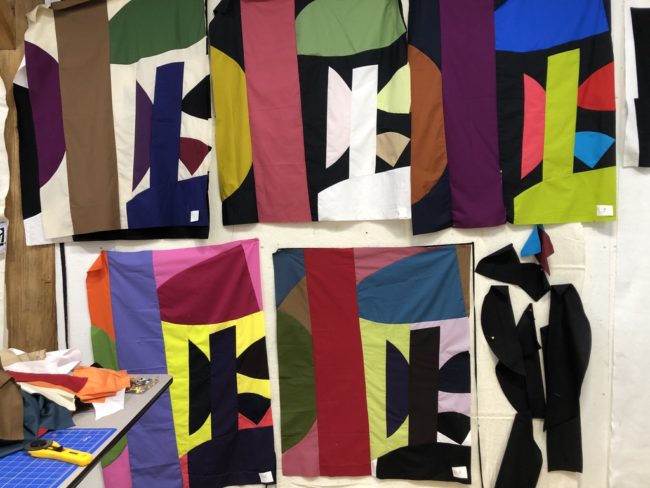
Five Color Studies Spring 2019 – Cindy Grisdela
As I said before, every time I learn something new, even if I’ve heard it before twenty times–which believe me, I have. This time it was the importance of figure/ground tension. “What are the Grounds doing?!” Nancy asks over and over. This time it sunk in–it’s not enough to look at the main players in a design, you have to see what the background shapes are doing in order to have a dynamic composition. And color. I think of myself as a colorist as an artist, but there’s always something new to learn. My approach is relatively intuitive, but Nancy has a more structured plan, and it helps to have that structure to hang my intuition on. Plus it forces me to use different colors and different combinations than those that are comfortable for me.
I’m going to be interested to see how all this gets integrated into my own studio practice.
Finally, I think that taking classes with other teachers makes me a better teacher, and that’s important to me.
Thanks for reading, and as always I’d love to hear your thoughts!
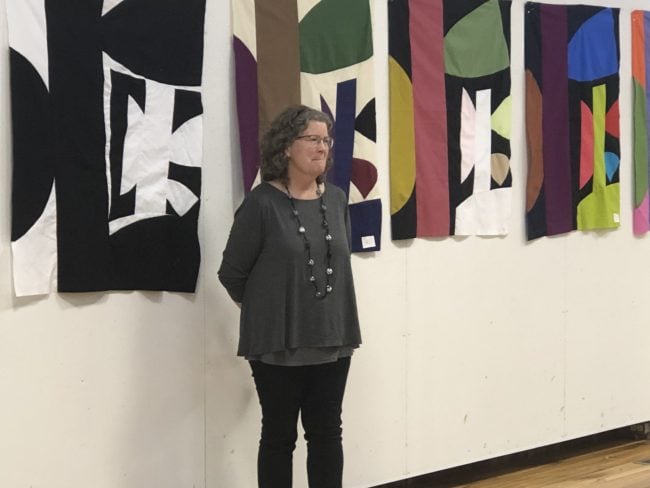

I want to learn more about your experience! That last tidbit was most curious to me: figure/ground tension. This is so different for a QUILT artist because the ground isn’t flat. We can fill the “ground” with so many different fiddly-bits 🙂 Did yo
u consider the quilting in your original composition? Were there other fiber artists in the class to give you feedback?
Thanks Sally! There were 20 other fiber artists in the group, so we could help each other. And no, we don’t consider the quilting at this stage–just the composition and design.
Cindy–What a wonderful experience, to so immerse yourself in your art, with a master to guide your intuition. I love following your creative journey, which gives me inspiration to trying new ideas myself!
Thank you Ruth–it was quite an experience. I’m glad you are inspired to try new things too!
It would be interesting to see some of the other ‘student’ works that came out of this two week workshop. I know you usually use solids, but did some of them use prints? Or was it a requirement to work with solids? Using different palettes than what we would normally choose is such a good idea! I remember, when I took a New York Beauty class with Judy Hasheider at the Wisconsin Quilt Expo, Judy had put together fabrics I never would have used together. But I love how my piece from that class looks.
Thanks Kris–it is interesting to work outside your comfort zone when it comes to color. We were required to use solids for this class–no prints allowed. I think that’s because the solids act more like paint in terms of creating lines and shapes–there’s no distraction from a printed color or line on the fabric.
Thank you for sharing. It is so interesting to see this and how you have tweaked your style over the years. Curious to hear more about what you learned about color. It seems like there is a shift toward blending, more gray tone colors in these experiments.
Thank you, Linda–my style is constantly undergoing tweaks to make it better, I hope! Mostly the color lessons center on value–how to see it and how to use it to your advantage when creating a design.
Cindy,
I really enjoy reading about your experiences at the Crow Barn. I admire your work. I find it inspirational and motivational to stretch myself as a fiber artist. One day, I hope to find myself at the Crow Barn; although it will be in the beginners class.
Thank you for sharing.
Joan
Thanks for responding, Joan. I appreciate your kind words and wish you all the best on your quilting journey!